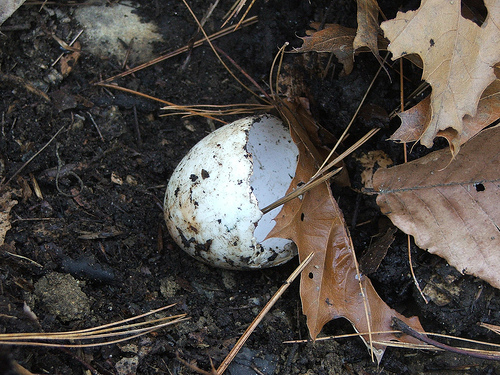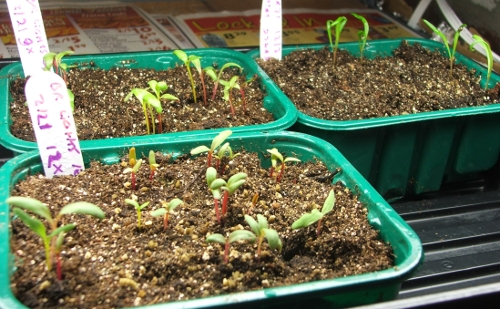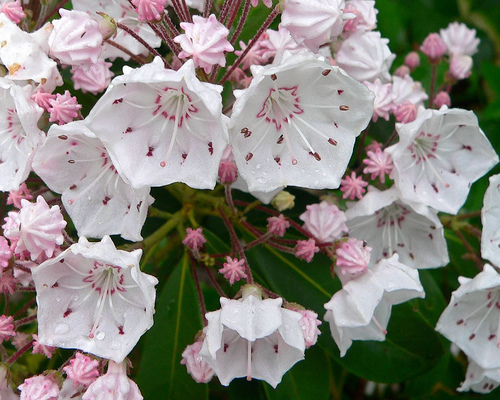
You guessed it: it’s time for another episode in the Calcium in the Soil and Plant series! Take heart: we’re getting close to the end (maybe only one more part to go?). Actually, it took me so long to post on this again because this one took me a long time to figure out. If you want to brush up on the previous parts, check out this page.
~
Part 8. Selective Nutrient (and Water) Uptake by Roots
Nutrients arrive at the root surface in three ways:
- The first of these is root interception. As roots grow, they make direct contact with nutrients. This mechanism is less important because roots come into direct contact with only 1-3 percent of the soil volume exploited by the root mass. Mycorrhizae – fungi that form a symbiotic association with plant roots – can increase the surface area that roots can extract nutrients from. Calcium and magnesium, because they are so abundant, are often intercepted by root contact.
- The second mechanism is mass flow, wherein plants, sucking up water (through the various pumps and pulls discussed in the previous part), also move the nutrients that are dissolved in it. Especially mobile (free) nutrients are “attracted†in this manner: nitrate-nitrogen, chloride and sulfur, which are never absorbed by the colloid and thus always exist in solution, and calcium and magnesium, which are held only loosely to the colloid. The drier the soil, the less mass flow.
- The third mechanism is diffusion, by which ions in the soil spontaneously move from a point of higher concentration to a point of lower concentration (like in osmosis). Diffusion happens in the soil because the immediate root area, once it is depleted, has a lower concentration of the nutrient ions. Immobile nutrients like phosphorus and potassium, which have a low solubility, are strongly held by the colloid, and are only present in small concentrations, reach the root through this mechanism. The soil porosity is important here: smaller pores will block diffusion.
The last two mechanisms are the more significant mechanisms of nutrient uptake. Which one is predominant depends on the nutrients, the amount of water in the soil and the physical conditions (e.g., crumb structure) of the soil which dictates the movement of water through it.
Nutrients (especially immobile ones) then need to be wrested from the colloid by an ion exchange – the cation exchange capacity (CEC) talked about on a soil test. As we saw, the positively charged nutrient cations are held to the negatively charged colloid by a small electro-magnetic bond. When the root hairs release hydrogen ions (H+) and these come into contact with the colloid, they take their places on the colloid, breaking or weakening the colloidal-nutrient bond. The nutrients are knocked free and this makes them more available to be taken up by the root hairs.
Once the nutrient has arrived at the plant root surface and has been made available, the root needs to take it in: the nutrient-ion needs to travel from the root’s exterior to its interior.
As we saw in Part 7, the membranes of the cells making up the epidermis and the endodermis of roots are semi-permeable. This means several things. First, roots allow movement in, but not out, which allows osmosis to take place, by which water is taken up by the plant roots (cf. Part 7). Second, they allow only small solutes in, so they are impermeable to the large molecules of organic solutes (more about that in the next part). Third, some small solutes are allowed in, but others are not: plant roots are selective about their food.
It is the last aspect that interests us here. The uptake of the nutrients (as well as sugars and amino acids) by the roots is selective because of two main features:
- First, the root membrane has channels that are ion-selective: one type of channel will let through only phosophorus ions, another fits only calcium ions, or potassium or nitrate, etc. Think of the toddler’s toy: the box with the star and pentagon and circular shaped holes into which only the star and pentagon and circular blocks fit. The root too is constructed like that.
- The actual ferrying through these channels is done by ion-selective carriers: so-called coupling proteins that are embedded in the membrane of the root cells and that only react with specific ions, passing them on. Different plants require different amounts of nutrients, and so they will have different types and densities of ion carriers on the surface of their cells. These ion carriers are also most numerous on the surface of root hairs and root tips, which shows that roots are the main conduit for nutrient uptake in plants.
That explains the root’s selection of particular nutrients. Now, how does it select their quantity? How does it say, that’s enough?
As for water, its protein carrier is the aquaporin. Aquaporins are embedded in the cell membrane, forming transmembrane pores that conduct just water molecules. They prevent the passage of ions and other solutes by a filter (the ar/R filter) of amino acids that bind only water molecules and let them in (single file), while excluding all other molecules. When there is a lack or an excess of water, a gating mechanism changes the shape of the aquaporin so that it blocks the pore and stops the water flow. These gates can fail and an excessive amount of water can break the gates, as it were, and “drown†a plant.
Nutrients like calcium ions are taken up by different transmembrane protein carriers, which actively transport them, that is, they require energy to do so, because they have to pull in ions against their concentration gradient. For instance, there’s a good chance the root cells already have a higher concentration of calcium than the soil in the root area, but it might still need more. The energy required comes from a part of the cell (called the ATP, a nucleotide). If the plant has enough of a nutrient, it can simply stop drawing on the energy source. Also this mechanism can fail, and an excess of nutrients can lead to a toxic overdose and kill the plant.
So, however well-equipped roots are to select what the plant is in need of, it is still up to us, gardeners, to know how much of what a certain plant in our care needs and how much of it is present in our soil.
~
Next up, nutrients not in mineral but in organic form, and how those can make it into the plants. Yes, the egg shells. Finally!






